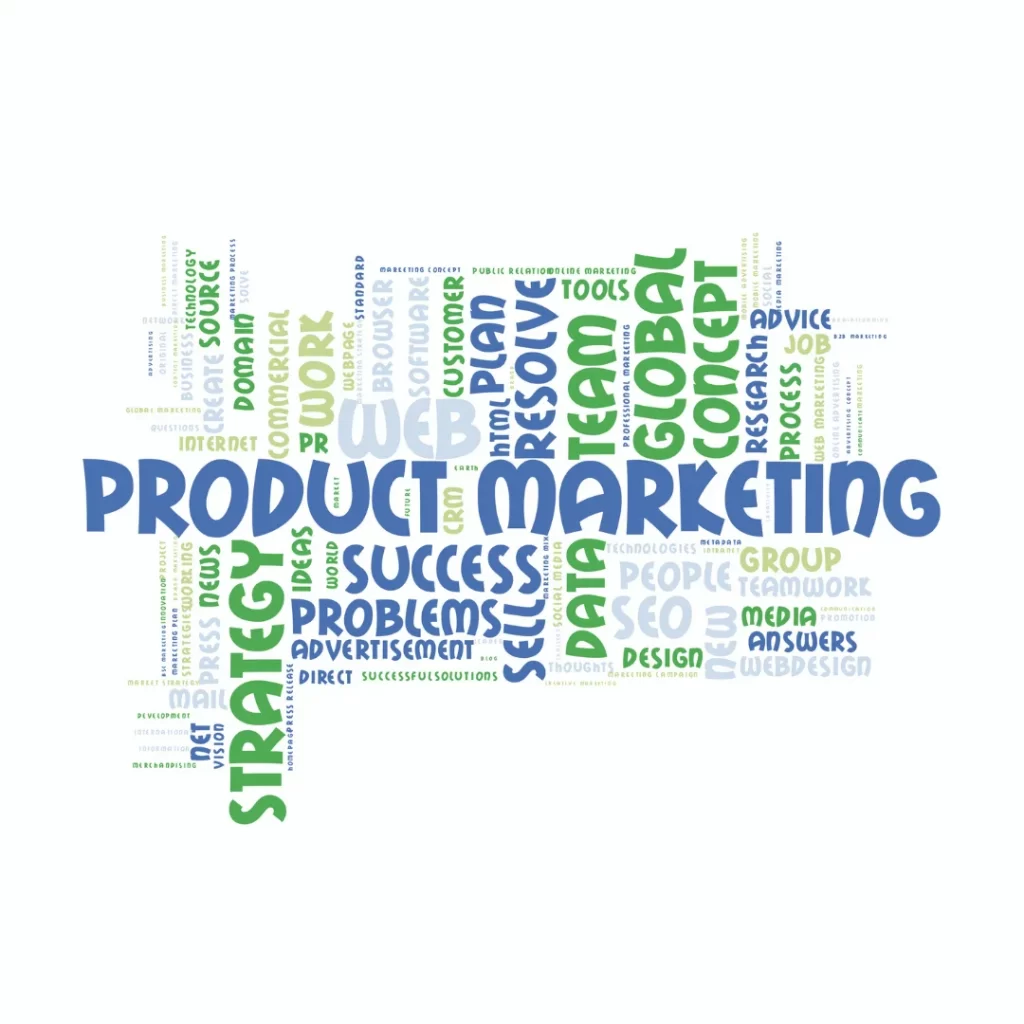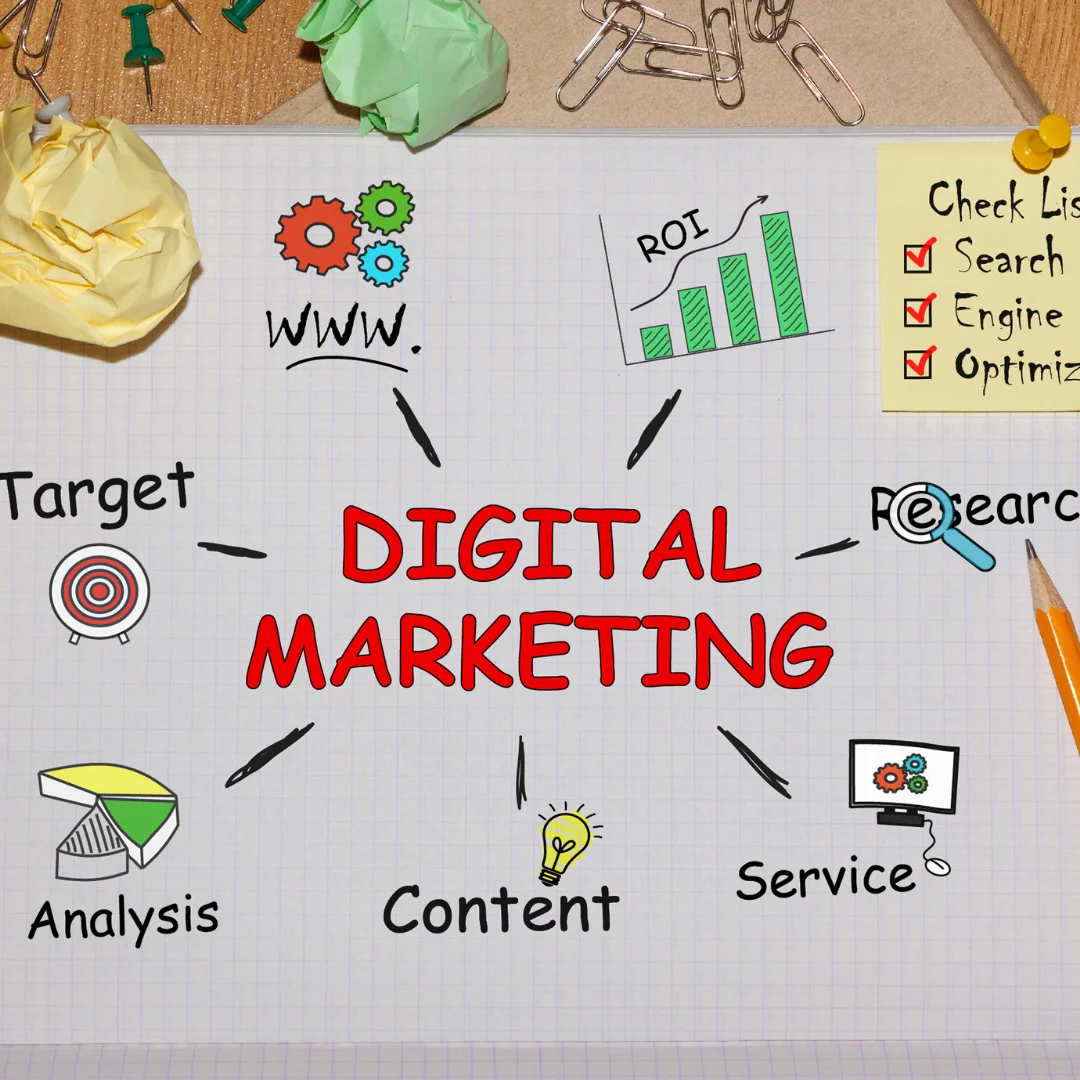Product marketing in the B2B tech startup world is a little like mixing rocket science with psychology. You’re not just selling a product; you’re selling a vision, convincing businesses that their lives will become exponentially better with your solution. But what does “product marketing” even mean, and why is it particularly crucial for B2B tech startups? This guide will walk you through everything—yes, everything—you need to know about nailing product marketing in a highly competitive, ever-shifting landscape.
Why Product Marketing Matters for B2B Tech Startups
Product marketing isn’t just about creating splashy ads or catchy taglines (though they certainly help). It’s about understanding your product’s role, positioning it effectively, and delivering a consistent message that hits the right nerves. Without it, even the best product might just sit there collecting digital dust. With the stakes high for B2B tech startups, this guide will provide insights to boost your product’s visibility, increase customer engagement, and ultimately drive business growth.
Understanding Product Marketing
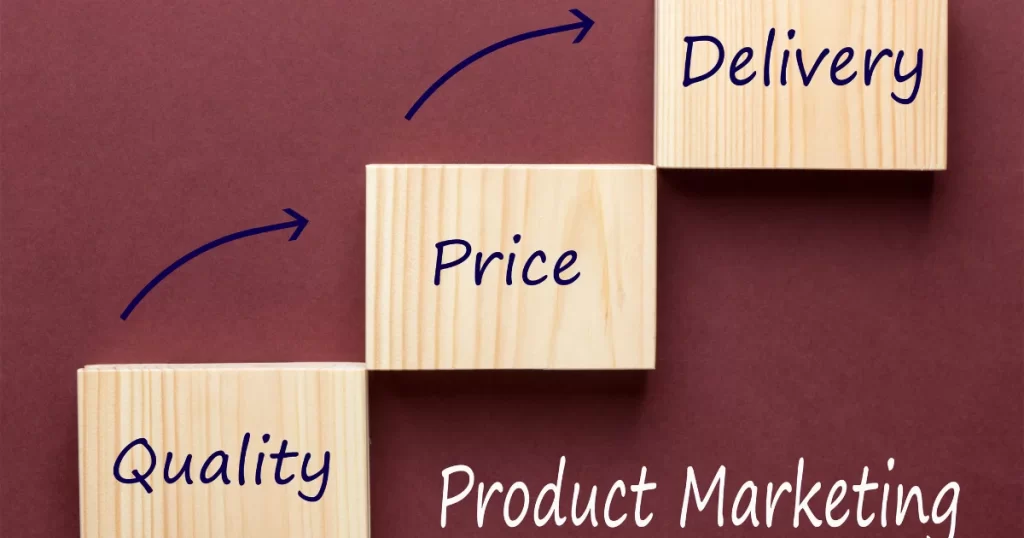
Product marketing is often misunderstood as just “marketing the product,” but there’s a lot more finesse involved, especially for B2B tech startups where your target audience can be skeptical, discerning, and (let’s be honest) difficult to reach. Product marketing is the art—and sometimes dark magic—of strategically positioning a product in a way that makes it feel like the perfect solution to your audience’s problems. In product marketing, it’s not about casting a wide net; it’s about precision.
What is Product Marketing?
Product marketing is all about bridging the gap between your product and the marketplace, positioning it so that your ideal customers recognize it as the answer to their issues. Think of product marketers as half-salesperson, half-psychologist. Unlike traditional marketing, which focuses on brand building and casting a wide net to pull in prospects, product marketing hones in on where the product sits in the market, its messaging, and, ultimately, its fit with the target audience’s needs. In other words, it’s product marketing is the matchmaker between what you’re offering and who you’re offering it to.
In a world where “product-market fit” determines whether your startup thrives or crumbles, product marketing ensures that your product doesn’t just float around but gets anchored in the minds (and hearts, if we’re being optimistic) of your target market.
Key Responsibilities of Product Marketers
Product marketers wear many hats, and no two days are ever quite the same. One day, they might be deep-diving into customer data, and the next, they’re writing sales collateral or training the sales team on how to pitch the product. Below are some core responsibilities of product marketers that keep them on their toes:
- Defining the Unique Selling Proposition (USP): The USP is what makes the product special in the eyes of customers. It’s that one big reason buyers should choose your product over the competition. Product marketers craft and refine this message so it’s clear, compelling, and consistently communicated across all channels.
- Building Market Strategies: Product marketers are strategists at heart, designing campaigns and plans that emphasize the product’s strengths and appeal to its target audience. From launch strategies to ongoing campaigns, they’re always iterating to keep the product front and center.
- Competitive Analysis: Staying a step ahead of competitors is key. Product marketers keep a constant eye on competitor moves, new market trends, and shifts in customer needs. Knowing what the competition is doing (and what customers are saying about it) helps product marketers refine their own product’s positioning and messaging.
- Sales Enablement: A product is only as good as the team that sells it, so product marketers work closely with sales teams, training them on the product’s benefits and providing materials that help communicate its value effectively. This might include developing pitch decks, brochures, or even just quick-hit talking points.
- Customer Insights: Product marketers keep a pulse on what customers want, what they like, and where they see room for improvement. This feedback is gold, guiding everything from feature prioritization to tweaks in messaging.
“Product marketers are a lot like spies—they’re always collecting intel on the market, the competition, and the customer, using it to sharpen their product’s edge.”
– Sarah S., Marketing Strategist
Product Marketing 101: The Product Life Cycle
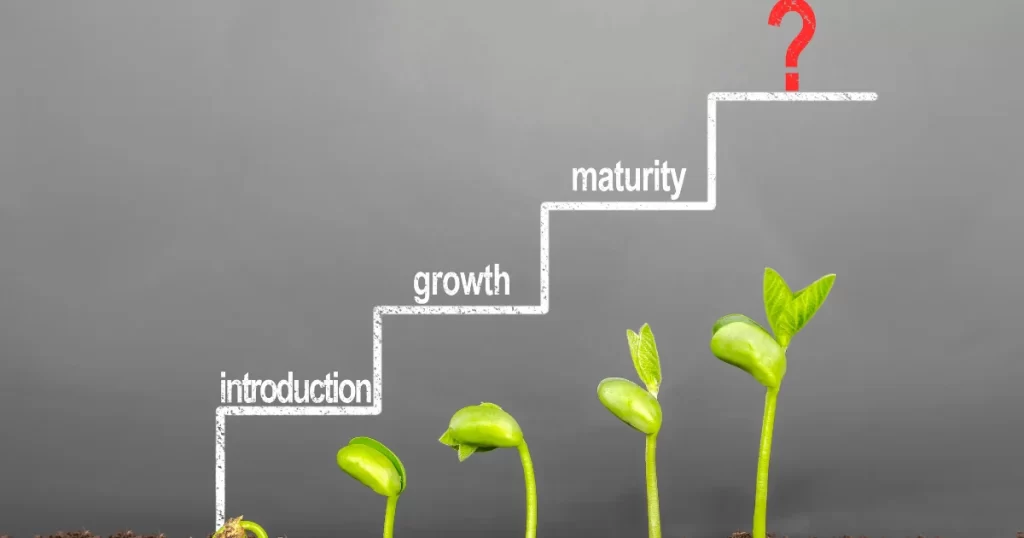
In product marketing, understanding the product life cycle isn’t just for textbook theory—it’s essential for startups. B2B tech startups face a fast-paced environment where market needs shift rapidly, competitors pop up out of nowhere, and the relevance of a product can dip as quickly as it rises. Knowing where your product sits within its life cycle stage helps in planning effective strategies and, let’s face it, deciding if it’s time to pivot or persevere.
| Stage | Characteristics | Focus of Product Marketing |
|---|---|---|
| Introduction | New product with low awareness. Initial buyers are early adopters. | Building brand awareness and establishing a foothold. |
| Growth | Demand increases, competitors emerge, and revenue grows. | Expanding reach, refining messaging, and targeting new segments. |
| Maturity | The market becomes saturated, growth slows, and price competition intensifies. | Focusing on differentiation and customer loyalty. |
| Decline | Sales drop as the product becomes outdated or new solutions emerge. | Either reinvigorating the product or planning a graceful exit. |
Stage 1: Introduction
In the introduction stage, a product is fresh on the scene, meaning awareness is low, and only the curious early adopters are giving it a try. Product marketing at this stage is all about building initial brand awareness and planting the flag. You’re not just launching the product; you’re making a statement about why it deserves attention.
Marketing efforts here are bold and memorable, designed to intrigue, attract, and set the foundation for long-term brand loyalty. This stage is high-stakes, but also exciting—you get to define the product’s identity and initial public perception.
Stage 2: Growth
Once the word’s out, the growth stage kicks in. Customers start to catch on, and with success, competitors will inevitably follow. Product marketers shift their focus to maintaining momentum, expanding their reach to new segments, and refining the product’s messaging to highlight benefits that resonate with a wider audience.
Refinement is the name of the game. The product marketer’s task is to keep demand on the up-and-up while also evolving the product’s position as more buyers enter the market.
“In the growth stage, the name of the game is differentiation. Your product isn’t just any solution—it’s the solution.”
– John M., Product Marketing Lead
Stage 3: Maturity
By now, you’ve hopefully built a solid customer base, but with that success comes the challenge of market saturation. Growth slows, competitors might start playing the price game, and differentiation becomes critical. Product marketers at this stage focus on customer retention, loyalty programs, and, perhaps, features that keep the product fresh in the eyes of its loyal users.
In a mature stage, product marketing’s task is to deepen the customer connection, reinforcing why they chose the product initially and why it continues to add value.
Stage 4: Decline
The dreaded decline—when sales start to dip, the product feels a bit dated, and newer solutions are stealing the limelight. But decline doesn’t have to mean defeat. Product marketers can either give the product a facelift (with updates and fresh marketing) or start crafting a strategy for a smooth phase-out.
Some products go through multiple declines and resurrections, and if the demand or utility is there, a smart product marketer can breathe life back into a product that might otherwise be cast aside.
“When your product hits the decline phase, you have two choices: rebrand and relaunch, or let it retire with dignity.”
– Lisa W., Head of Product Marketing
For B2B tech startups, understanding these life cycle stages isn’t optional—it’s essential. Startups rarely have the resources to drag along a product that’s stalled, so each stage demands its own unique strategies, from building awareness to differentiating fiercely against competitors to eventually deciding if (or when) it’s time to bow out gracefully.
Each stage of the product life cycle presents a distinct set of challenges and opportunities. Product marketers with a keen eye on where their product stands are better equipped to navigate these stages, avoid costly missteps, and, ultimately, give their startups the best chance to thrive.
Market Research and Buyer Personas

Market Research: The Foundation of Targeted Product Marketing
When it comes to product marketing, understanding your audience is everything. It’s the difference between trying to navigate a maze with a flashlight or blindly feeling your way through. Effective market research lights the path forward, revealing the preferences, pain points, and purchasing triggers of your potential customers. Without this critical step, product marketing becomes a game of chance—and that’s not a game you want to play.
Techniques for Conducting Effective Market Research in Product Marketing
To gather robust insights, blend quantitative data (the hard numbers) with qualitative insights (the deeper “why” behind those numbers). Here’s a breakdown of both approaches:
Surveys
Surveys are a simple yet powerful tool. They offer direct insights by asking questions your audience can answer at their own pace. Keep the questions focused on your product’s value points and ask about specific challenges, preferred solutions, and buying triggers.
Example: A SaaS company surveying CFOs could ask, “What’s your biggest challenge in managing cross-departmental expenses?” This question zeroes in on a pain point without sounding too “salesy.”
Interviews
For deeper insights, nothing beats face-to-face (or Zoom-to-Zoom) conversations. Interviews allow you to probe and clarify responses, understanding not just what users want but why. Go beyond surface-level inquiries and ask follow-up questions to get to the heart of customer motivations.
“The more we understand the ‘why’ behind customer decisions, the more effectively we can meet their needs”
– Julia Carter, product marketing strategist.
Social Media Analysis
Monitoring social media offers an unfiltered look at your audience’s thoughts on your product, competitors, and industry trends. Use social listening tools to track mentions of your product and identify patterns in feedback and sentiment. Analyze conversations around your competitors too—sometimes, customers will reveal exactly what they want but aren’t getting.
Competitor Analysis
A critical part of product marketing is knowing where you stand relative to the competition. Competitor analysis not only informs your positioning but also highlights any unfulfilled market needs. Look at competitor pricing, features, messaging, and customer complaints. If customers regularly mention a competitor’s poor customer service, you know what to highlight in your own offering.
“A competitor’s weakness is often a product marketer’s opportunity,”
– Olivia Reyes, CEO of MarketStride.
By blending these techniques, you’ll walk away with a full 360-degree view of the market, revealing the landscape and your target audience’s expectations. With this insight in hand, your marketing strategy becomes targeted and meaningful, rather than a shot in the dark.
Crafting Buyer Personas: A Detailed Blueprint of Your Ideal Customer
Think of a buyer persona as your audience’s “character profile.” Just as a well-written character in a novel has a rich backstory, challenges, and quirks, your ideal customer should be fleshed out in similar detail. Buyer personas help clarify how your product integrates into a customer’s daily routine, solves their issues, or makes their life easier.
What to Include in a Buyer Persona:
- Demographics and Psychographics
Start with the basics: age, income level, geographic location, job title, industry, and role. But don’t stop there. Dive deeper with psychographics—such as attitudes, values, and lifestyle. For example, a tech startup targeting CFOs may create a persona named “Budget-Conscious Blake,” who is cautious about new expenditures but understands the value of data automation. - Challenges and Pain Points
What keeps your target persona up at night? Pain points reveal what customers feel they’re lacking and where your product fits as a solution. In Blake’s case, the issue might be “manual, time-intensive financial reporting.” This pain point will directly influence how you position your product’s benefits. - Goals and Motivations
Knowing what drives your persona is essential. Are they aiming to boost team efficiency? Improve accuracy? Save time? For Blake, the primary goal might be “reducing reporting time by automating repetitive tasks,” and the motivation might be “streamlining department operations without hiring more staff.” - Preferred Communication Channels
Understanding where your buyer persona “hangs out” online helps you reach them with the right message in the right place. CFOs might be heavy LinkedIn users and prefer email communication over SMS or social media direct messages. This knowledge informs your outreach strategy.
Example Persona:
| Persona Name | Budget-Conscious Blake |
|---|---|
| Job Title | CFO at a mid-sized tech company |
| Pain Points | Manual financial reporting, lack of real-time expense tracking |
| Goals | Streamlining financial reporting, reducing error rates |
| Preferred Channels | LinkedIn, email |
| Product Message | “Save time and boost accuracy with our automated reporting tool designed for finance leaders.” |
By fleshing out personas to this level of detail, you’re not just creating an abstract “target audience”—you’re crafting a strategy that speaks to an actual person’s needs and desires.
Buyer Personas in Action: Your Roadmap for Messaging and Positioning
A well-crafted buyer persona guides the messaging and positioning of your product in nearly every campaign. Here’s how:
- Product Messaging: Your messaging should directly address pain points and goals outlined in the persona. With “Budget-Conscious Blake” in mind, you might focus on time savings, automation benefits, and the ability to scale processes without additional hiring.
- Marketing Channels: Knowing Blake’s preferred communication channels allows you to focus efforts on platforms that will reach him effectively. This prevents wasted resources on channels that don’t align with his usage habits.
- Personalization: Personas also help tailor campaigns. For example, if Blake’s company is cost-conscious, a personalized email campaign emphasizing the cost-saving benefits of your product’s automation features would resonate better than a generic message.
A thoughtful approach to market research and persona development keeps product marketing on track, ensuring that every message hits home and every feature aligns with a real need. Product marketing isn’t just about launching products; it’s about understanding the people who use them and creating value in ways they care about most.
Targeting and Positioning Strategies in Product Marketing

Targeting and positioning in product marketing is the art (and sometimes a bit of psychological warfare) of identifying and appealing to your ideal customers. This isn’t about simply listing out demographics and crossing your fingers—it’s a precise, thoughtful process that aims to make your product resonate deeply with a specific audience. Let’s break down the key components in product marketing, with a few tips to keep your strategy both relevant and, well, realistic.
Ideal Customer
Who really wants your product? It’s tempting to think “everyone,” but in reality, the best results come from targeting a well-defined group. And it’s not just demographics like age or location we’re talking about here; effective product marketing targets psychographics, job roles, and even more nuanced aspects of your audience’s lives.
Consider these dimensions for a fully fleshed-out target:
- Psychographics: These are the attitudes, aspirations, and interests that shape your customers. Are they perfectionists? Do they prioritize cost over quality? Are they tech-averse or eager early adopters? Knowing these traits will give your messaging that extra kick.
- Job Role and Responsibilities: Say your product is a financial reporting tool. Targeting “finance professionals” is a good start, but let’s narrow it down: Are you speaking to CFOs in mid-sized tech firms? Financial analysts in corporate behemoths? The answer will determine everything from how complex your messaging is to the kind of jargon (or lack thereof) you use.
- Business Size and Industry: A solo entrepreneur might have different pain points compared to a large, multi-level corporation. The size of the business and its industry quirks will affect everything from pricing expectations to preferred features.
💡Pro Insight: “Great targeting is less about who you want and more about who you don’t want,” says Sam Tran, Marketing Strategist at Digital Sphere. “It’s about excluding the ones who don’t match up with your product and honing in on those who’ll get the most out of what you’re offering.”
Positioning
Positioning is your product’s chance to stand out, to scream “I’m what you’ve been looking for!” in a sea of options. It’s not just about filling a market gap but about creating a unique value proposition that tells your audience why they should care.
To craft compelling positioning, focus on:
- Unique Value Proposition (UVP): Your UVP is the promise of value that you can deliver better than anyone else. To define this, ask yourself: What’s the one thing your product does incredibly well? Or, better yet, what would customers lose if your product suddenly vanished from the market?
- Differentiators: Identify what makes your product unique in the eyes of the customer, whether it’s price, quality, speed, or a particular feature. Differentiators should be front and center in your messaging, offering instant clarity on what makes your product the clear choice over a competitor’s.
- Proof of Value: You may know your product’s worth, but that’s no use unless the customer knows it too. Customer testimonials, case studies, or detailed product demos can effectively demonstrate this value and give prospects a clear reason to trust your positioning.
💡Pro Insight: “Positioning is all about perception,” says Jamie Liu, Head of Marketing at RapidLaunch. “It’s not just how you see your product, but how you want customers to see it. And don’t think it’s a ‘set-it-and-forget-it’ deal; as your product grows and your competitors respond, so should your positioning.”
Messaging
Good messaging is like a good handshake—firm, clear, and leaves an impression. Your message should hit on both an emotional and practical level, speaking directly to your target customer’s needs, aspirations, and even fears. Keep it authentic, compelling, and memorable.
Consider the following:
- Emotional Resonance: People make buying decisions based on emotions, then back them up with logic. Address customer pain points directly, and show empathy for their challenges. They’ll connect more with a solution that “gets” them than one that simply lists features.
- Consistency: Once your positioning is clear, make sure every piece of communication reflects it. Whether it’s a tweet, a blog post, or a landing page, your messaging should always align with the core promise of your product. Consistency builds trust, and trust translates to conversions.
- Adaptability: As your product, audience, and market evolve, so should your messaging. Regularly review and update it to ensure that it remains relevant and engaging.
💡Pro Insight: Marketing expert Jess Clayton says, “Effective messaging isn’t just about what you say—it’s about how you say it, and more importantly, how often. Repetition breeds familiarity, and familiar messages are the ones that convert.”
Example Table: Mapping Targeting Elements to Strategy
| Targeting Element | Description | Example |
|---|---|---|
| Psychographics | Attitudes, aspirations, and interests | Eco-conscious buyers for a sustainable brand |
| Job Role | Position and responsibilities within the company | CFOs responsible for budgeting and analysis |
| Business Size | Scale and industry of the target business | Mid-sized tech companies with <500 employees |
| Unique Value Prop | What sets your product apart | Fastest processing speed in its category |
| Emotional Resonance | Messaging that connects on a personal level | “Finally, a product that saves you time and headache” |
| Consistency | Keeping all communications aligned with the core message | Every ad, email, and social post reflects ‘speed and simplicity’ |
By focusing on these elements, you can build a targeting and positioning strategy that ensures your product doesn’t just enter the market; it makes a lasting impression.
Effective Product Marketing Strategies for Startups
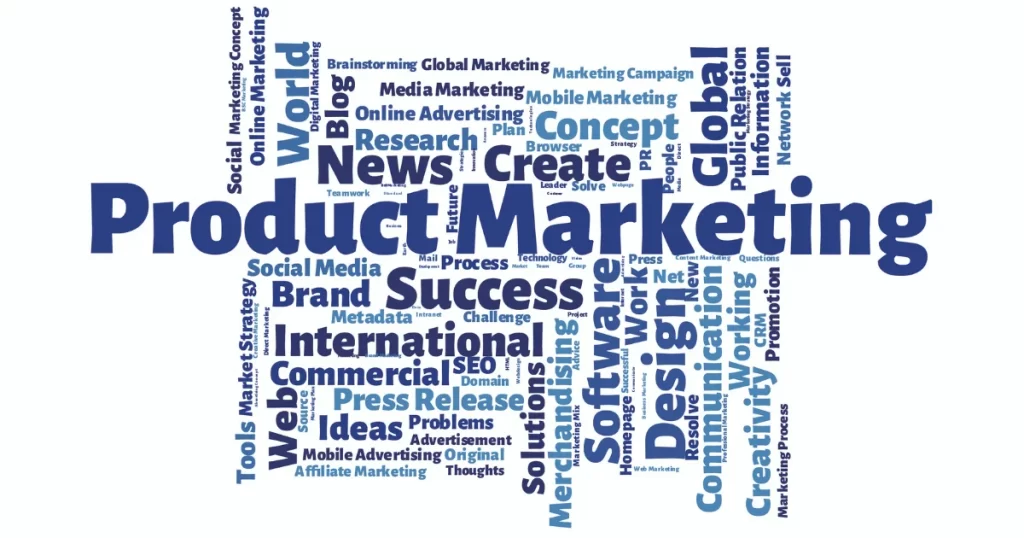
If you’re a B2B tech startup, it’s likely that you have an innovative product and ambitious goals—but maybe not a limitless marketing budget. And while massive budgets might look appealing, they’re often unnecessary for savvy startups that know how to harness creativity, resourcefulness, and sharp strategy. Here’s a breakdown of effective marketing strategies for B2B tech startups that keep your financial sanity intact while making your product marketing campaign a force to be reckoned with.
Lean but Powerful: Core Product Marketing Strategies for Maximum Impact
The best marketing strategies for B2B startups are those that allow you to move fast, adapt quickly, and make a big splash in your niche. Below are a few approaches that pack a punch without needing a small fortune:
- Identify and Develop Your Unique Selling Proposition (USP): Your USP is the cornerstone of your marketing strategy, especially when budgets are tight. Clearly articulate what sets your product apart and build your messaging around this distinction. Consider this your north star—it’s what’ll draw your target market like moths to a flame (or a revolutionary CRM solution, as the case may be).
- Embrace Content Marketing (and Milk It for All It’s Worth): Content marketing is the gift that keeps on giving. Blog posts, whitepapers, case studies, and infographics provide ongoing value to your audience while establishing you as an industry expert. Keep in mind that B2B buyers typically do extensive research before making purchasing decisions. By serving up high-quality, educational content, you’re helping them make informed choices and planting seeds for a long-term relationship.
- Social Media for B2B? Absolutely. Social media isn’t just for lifestyle brands and meme pages. LinkedIn is the B2B playground, but don’t overlook Twitter, where thought leadership content thrives. Use these platforms to share your expertise, engage with potential clients, and keep an ear to the ground on industry trends. And remember: the trick is to blend educational content with a touch of personality. Robots don’t sell well—humans do.
- Leverage Customer Testimonials and Case Studies: B2B buyers crave proof. They’re not interested in hearing what you think your product can do—they want evidence from companies like theirs. Testimonials, case studies, and user-generated content (UGC) are powerful ways to provide social proof and build trust.
- Tap into Email Marketing: The good ol’ inbox isn’t going anywhere, and email marketing remains a cost-effective way to nurture leads and keep prospects engaged. Drip campaigns, newsletters, and personalized follow-ups offer a consistent, measurable way to communicate with your audience. Plus, it’s an excellent vehicle for educating prospects, sharing updates, and building loyalty.
💡Pro Insight: “Startups that invest early in email marketing are building relationships that often outlast social media trends,” says digital marketer Evan Wood. “Email gives you direct access to your audience without fighting the algorithm.”
Balancing Traditional and Digital Marketing Tactics
So, you’re ready to roll up your sleeves and tackle marketing—but where to start? A balanced approach that blends digital and traditional marketing can give you the best of both worlds. Here’s why it works and how to optimize each tactic.
Why a Hybrid Approach Works
Digital marketing is cost-effective, highly targeted, and perfect for nurturing long-term relationships. But traditional tactics like industry events, partnerships, and direct outreach can also add a personal touch that’s often missing in the digital sphere. B2B buyers, particularly in tech, value expertise and trustworthiness. Meeting them face-to-face, either literally or through polished traditional materials, can build these qualities faster.
- Digital Marketing: SEO, Content, and Social Media
- SEO-Driven Content Marketing: An optimized blog is one of the most powerful tools in your arsenal. B2B buyers are meticulous researchers, scouring Google for trustworthy resources. Your content, optimized with SEO and laden with value, can establish you as an authority while boosting your visibility.
- Social Media Engagement: Use LinkedIn and Twitter to amplify your product marketing message. Engage directly with prospects by commenting on industry conversations, sharing updates, and offering insights. Social platforms are a great place to demonstrate your knowledge and keep your brand top-of-mind.
- Traditional Marketing: Events, Partnerships, and More
- Industry Events and Conferences: Show up where your audience is. Attending or even hosting webinars, live demos, or panels lets you showcase your expertise, collect leads, and directly engage with potential customers.
- Strategic Partnerships: Partner with complementary companies to expand your reach. Whether it’s cross-promoting content, running joint webinars, or simply referring clients, partnerships give you access to an audience that’s already primed for your product.
💡Pro Insight: According to B2B strategist Jodi O’Donnell, “Startups that are agile enough to experiment with both digital and traditional tactics have the best chance at finding their sweet spot. Marketing isn’t a one-size-fits-all solution—it’s about blending and balancing to see what sticks.”
Example Table: Traditional vs. Digital Marketing Tactics for Startups
| Marketing Tactic | Description | Startup Advantage |
|---|---|---|
| SEO-Driven Content Marketing | Creating blog posts and articles that rank | Increases visibility, establishes authority |
| Social Media Engagement | Building a presence on LinkedIn, Twitter, etc. | Direct engagement, brand awareness |
| Industry Events and Webinars | Attending, hosting, or participating in events | Builds trust, connects directly with leads |
| Strategic Partnerships | Collaborating with complementary businesses | Access to new, relevant audiences |
| Email Marketing | Sending targeted, segmented emails | Personal connection, lead nurturing |
Final Word: Creativity Beats Cash in Startup Product Marketing Marketing
Yes, marketing budgets are nice, but they aren’t everything. A creative approach—one that is agile, customer-centric, and balanced between digital and traditional strategies—can help your B2B startup break through the noise and establish a presence that resonates with your ideal audience. Don’t let a tight budget hold you back; in the end, great product marketing is about understanding what makes your audience tick and using that insight to deliver value in every interaction.
By implementing a balanced, targeted approach and staying adaptable, you’ll position your brand not just as another option, but as the best option.
Sales Enablement Techniques in Product Marketing

Sales enablement is the B2B product marketer’s secret weapon. Imagine a world where sales reps are perfectly in tune with your product’s messaging, confidently delivering the value proposition to prospective customers. That’s what effective sales enablement brings to the table. For a B2B tech startup, the importance of this alignment can’t be overstated. Sales enablement bridges the gap between marketing’s lofty vision and the practical needs of salespeople who are out there hustling, meeting targets, and ultimately converting leads.
Creating Effective Sales Collateral
Your product might be innovative, but without well-crafted sales collateral, your team is essentially going to battle without armor. High-quality sales collateral does more than just explain your product—it makes an impact. Here are some crucial types of collateral and why they work:
- Case Studies
Real-world success stories are invaluable. Prospects want to know how your product has solved problems for others, especially within their industry. These case studies should focus on the pain points addressed, the process of implementation, and the results. They give prospects the confidence to trust your brand. - White Papers
For those leads who prefer a more in-depth analysis, white papers are essential. These aren’t light reads—they’re designed for those who want data-driven, research-backed information that demonstrates how your product solves a specific problem. A white paper can be the difference between a prospect merely considering your product and a prospect needing to know more. - Demo Videos
Video remains one of the most engaging mediums. A demo video that shows the product in action can quickly communicate its value, especially when complex software is involved. Prospects want to see the user interface, workflow, and how the product solves problems in real time. Make these videos crisp, clear, and actionable. - FAQ Sheets
As prospects move further down the sales funnel, they inevitably have specific questions. An FAQ sheet that anticipates these inquiries—and provides honest, straightforward answers—can expedite the decision-making process. Addressing concerns openly builds trust, and a little transparency goes a long way. - Playbooks
Think of a sales playbook as the ultimate cheat sheet for your sales team. It provides a rundown of key messaging, objection handling, competitive differentiation, and more. Your sales team won’t have to second-guess their approach; they’ll have a structured strategy that aligns perfectly with your marketing objectives.
To make sure these materials hit the mark, product marketers need to work closely with the sales team. This collaboration helps ensure the collateral is not only relevant but actually useful in the field. After all, it doesn’t matter how beautiful a case study looks if it’s not aligned with what prospects are asking about.
Measuring Product Marketing Impact

As inspiring as it can be to craft compelling product messaging and roll out creative marketing campaigns, product marketing isn’t just a feel-good exercise. Measurement is essential to understand what works and what doesn’t—and in a startup, you can’t afford to invest in anything that doesn’t drive results.
Key Performance Indicators (KPIs)
To truly grasp how effective your product marketing efforts are, focus on metrics that tie directly to growth, revenue, and customer satisfaction. Here are some essential KPIs for B2B tech startups:
- Customer Acquisition Cost (CAC)
CAC is the sum of all costs (advertising, salaries, software) involved in acquiring a new customer. In essence, it shows how efficiently you’re turning your marketing dollars into new business. High CAC might indicate an issue with your product positioning or market fit. Aim to lower CAC over time, indicating you’re creating a more efficient acquisition process. - Lead Conversion Rates
Not all leads are created equal, and this metric helps you understand the effectiveness of your nurturing efforts. Lead conversion rates reveal how many prospects move from one stage of the funnel to the next and, ultimately, to closed deals. High conversion rates suggest that your messaging is resonating with prospects, while low rates could mean you’re attracting the wrong audience or need to tweak your approach. - Customer Retention and Lifetime Value (LTV)
Acquiring new customers is great, but keeping them is even better. Customer retention metrics tell you how well your product is meeting ongoing needs and how satisfied your customers are over the long term. Coupled with lifetime value (the revenue generated by a customer over their entire relationship with your company), these metrics give you insight into the health of your customer relationships. - Overall Market Share
For B2B tech startups, market share can be tricky to measure, but it’s an important indicator of your brand’s influence within the industry. This metric helps you understand how you’re performing relative to competitors. If your market share is growing, that’s a positive sign that your marketing strategies are working. However, if it’s stagnating or declining, it might be time to reevaluate. - Product Adoption Rates
Product adoption rates track how quickly new users are engaging with your product after purchase. A high adoption rate suggests that onboarding materials and product documentation are doing their job. Low adoption rates, on the other hand, might mean your product isn’t as intuitive as it could be or that users are struggling to see its value. - Customer Satisfaction Scores (CSAT, NPS)
How happy are your customers? Tools like the Net Promoter Score (NPS) and Customer Satisfaction Score (CSAT) are invaluable here. These scores give you direct feedback from customers about their experience with your product and brand. High scores generally correlate with high customer retention and potential for referrals.
Table of Key Metrics for B2B Product Marketing
| Metric | What it Measures | Why It’s Important |
|---|---|---|
| Customer Acquisition Cost | Cost of acquiring a new customer | Gauges efficiency in customer acquisition |
| Lead Conversion Rate | Percentage of leads converting to customers | Measures the effectiveness of lead nurturing efforts |
| Customer Retention | Percentage of customers retained over time | Indicates customer satisfaction and loyalty |
| Market Share | Company’s portion of total market sales | Shows competitive standing in the industry |
| Product Adoption Rate | Rate of new user engagement post-purchase | Reflects onboarding and product appeal |
| CSAT and NPS | Customer satisfaction and loyalty | Provides feedback on customer happiness |
By consistently tracking these KPIs, you can make data-driven decisions that refine your marketing strategy, boost ROI, and drive sustainable growth for your startup. After all, marketing might start with creativity, but it should end with measurable success.
Adapting Product Marketing Strategies Based on Feedback
Adaptation in product marketing is more than a buzzword—it’s a survival tactic. For B2B tech products, which constantly encounter shifts in user needs, evolving features, and sometimes even dramatic changes in the market landscape, adaptability isn’t optional; it’s essential. Companies that cling to outdated strategies get left behind, while those open to feedback stay relevant and responsive.
Customer Feedback: The Fuel for Product Growth in Product Marketing
Think of customer feedback as the pulse of your product’s success. Gathering and acting on feedback not only refines the product but also nurtures your customer relationships. Customers love being heard, and when their feedback translates into product updates, you’re solidifying their loyalty. This process often happens through structured channels like surveys, user testing sessions, and real-time chats with the customer success team. But here’s the thing: it’s not enough to collect feedback—you have to act on it.
Strategies for Continuous Improvement
Creating a feedback loop that’s constant and integrated into every phase of your product lifecycle is key. Imagine a cycle where feedback drives every update, enhancement, and feature release. To set this up, first, ensure you have robust methods for collecting and analyzing customer feedback. This data should then feed directly into the product development cycle.
For example, say a major pain point for users is navigation through a complex dashboard. By identifying this issue and funneling it to the development team, you’re not just improving the product; you’re proving to customers that you genuinely care about making their experience smoother. The result? Stronger loyalty and a customer base that’s likely to recommend your product.
“Listening to customer feedback is like reading the map to product success. Ignore it, and you’ll lose your way,”
– Alex Coleman, product strategist and former head of customer insights at TechWave.
Account-Based Marketing (ABM) for Enterprise Clients
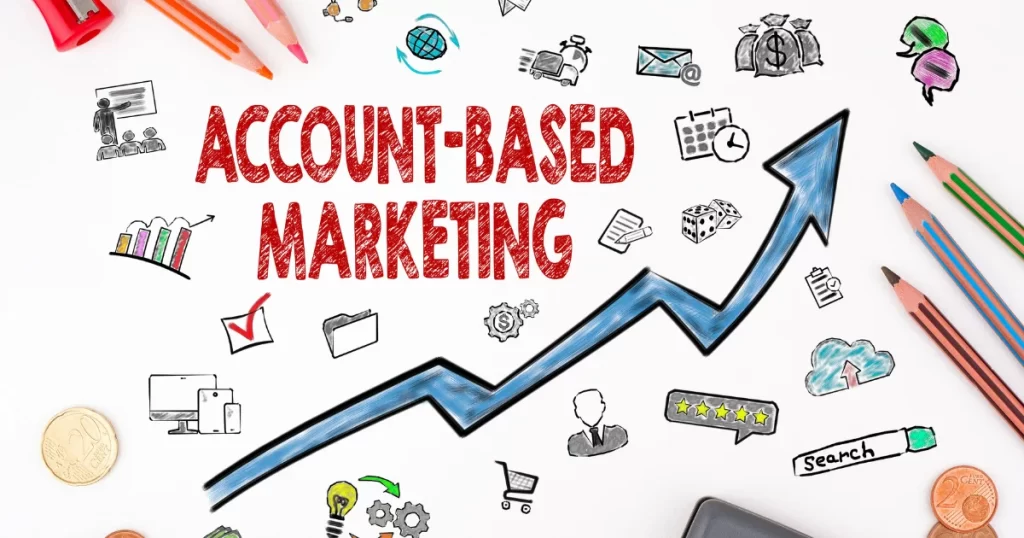
Account-Based Marketing is the MVP for targeting enterprise clients in the B2B sector. ABM flips the script on traditional lead-gen techniques by focusing on key accounts with high potential rather than casting a wide net. This highly focused approach is a game-changer for startups looking to land substantial deals with enterprise clients, where a single contract can significantly impact revenue.
Personalization Techniques in ABM
ABM is not about marketing to a general audience; it’s about creating tailored messages for specific clients. With ABM, each account becomes its own mini-market, and the level of personalization required is on another level. Rather than a one-size-fits-all email blast, ABM often involves personalized content like industry-specific case studies, customized solution briefs, and even one-on-one presentations for C-suite stakeholders.
“ABM is like walking up to a big enterprise and saying, ‘Hey, this is exactly how our solution can solve your unique problems,'”
– Sarah Gray, ABM specialist at EngageGlobal.
The process requires extensive collaboration between sales, marketing, and customer success teams. Imagine you’re trying to land a software contract with a massive retail client. Rather than pitching them a generic list of features, you might develop a custom demo showcasing how your product integrates with retail analytics, optimizing inventory based on their current systems. This hyper-relevant approach not only grabs attention but demonstrates a deep understanding of the client’s specific challenges.
To break it down further, let’s look at a few practical personalization techniques within ABM:
| Technique | Description |
|---|---|
| Custom Presentations | Tailor each presentation to address the unique challenges of the target enterprise. |
| Industry-Specific Content | Create case studies or white papers that align directly with the prospect’s industry. |
| One-on-One Meetings | Hold exclusive sessions where stakeholders can see a personalized demo in action. |
| Tailored Follow-Ups | After initial contact, follow up with relevant information based on their specific pain points. |
| Joint Planning Sessions | Collaborate with the potential client’s team on pilot projects, demonstrating real ROI. |
ABM’s strength lies in its precision. Rather than wooing dozens of leads, you’re investing in a select few accounts with high-value potential. It’s a bit like dating; rather than sending out a mass invite, you’re taking the time to understand, communicate, and show that you’re the ideal partner.
“ABM isn’t marketing as usual; it’s about knowing your prospect inside and out. It’s about convincing them you’re exactly what they need,”
– Steve Rankin, ABM lead at TechRise Solutions.
With both these strategies—adapting based on feedback and using ABM to target enterprise clients—you’re building a product marketing approach that is as dynamic as it is calculated. Each tactic relies on understanding and responding to customer needs with precision, whether through iterative product updates or laser-focused marketing techniques. And at the heart of it all? It’s about making customers feel valued, heard, and understood.
Launch Management Best Practices For Product Marketing
So, you’ve got the product ready—now, how do you launch it so that it doesn’t just make a splash but sends tidal waves? That’s where launch management comes in. It’s your grand debut, the product’s opening night, and you need everything from timing to communication on point to make sure your product reaches the right audience with maximum impact.
Key Components of a Successful Launch In Product Marketing
Getting a launch right involves orchestrating several moving parts, and each stage, from pre-launch to post-launch, is an opportunity to maximize impact. Here’s how to break it down:
1. Pre-Launch Teasers: Building Anticipation
If a tree falls in a forest and no one’s there to hear it, does it make a sound? Likewise, if you launch without warming up your audience, don’t expect much noise. Teasers are your chance to build anticipation, generate buzz, and create a sense of exclusivity around the product. Consider targeted email campaigns, teaser videos, and limited insider previews for your loyal customers. Drop hints on what’s coming without giving too much away.
2. Strategic Announcements: Go Big or Go Home
This is where your product officially steps into the spotlight. Announce it loudly and strategically. Focus on press releases, social media takeovers, blog posts, and even virtual events. Make sure your message is unified across all platforms—this is product marketing on full display, and the goal is to grab as much attention as possible. Timing matters too; for example, don’t launch on a Friday afternoon when half your audience is already mentally in weekend mode.
“A launch is like a movie premiere—you only get one shot to make that unforgettable first impression,”
– Ella Tran, Launch Manager at TechEdge.
3. Post-Launch Follow-Ups: Keep the Conversation Going
A launch doesn’t end once the product is live. Post-launch follow-ups allow you to maintain momentum and re-engage users. Send out emails that explain key features in detail, publish case studies on early adopters, and highlight user testimonials. Show your audience that this product isn’t just another release; it’s a game-changer. Plus, this is a great time to gather feedback from those early users, which can inform immediate tweaks or updates.
Training Internal Teams
Your product’s biggest champions should be the people who know it inside and out—your internal teams. It’s crucial to train your sales, customer service, and support teams before the launch. They’re going to be fielding questions and addressing concerns from day one, and you don’t want them fumbling around. Invest in training sessions and provide resources like FAQs, demo scripts, and feature lists.
Launch Day: Execution and Crisis Management
On launch day, have a dedicated team ready to tackle any unexpected issues. Murphy’s Law is real—no matter how much you prepare, something might go sideways. Maybe a feature bugs out or the website traffic causes your servers to crash. The trick is to prepare for the unexpected. Assign team members to manage social media, oversee technical support, and respond to customer inquiries in real-time.
| Launch Component | Description |
|---|---|
| Pre-Launch Teasers | Build anticipation through targeted campaigns, hinting at the upcoming product. |
| Strategic Announcements | Officially introduce the product with coordinated press releases and social media posts. |
| Post-Launch Follow-Ups | Maintain momentum through detailed emails, user case studies, and feature highlights. |
| Training Internal Teams | Ensure sales, support, and customer service teams are fully equipped to handle inquiries. |
| Launch Day Management | Have a dedicated team on standby for any technical or customer service hiccups. |
“A successful launch isn’t about avoiding problems—it’s about being ready to handle them smoothly when they happen,”
– Marvin Ross, Product Launch Consultant.
Collaboration Across Teams: A Necessity For Product Marketing

Product marketing isn’t a solo performance—it’s a carefully choreographed ensemble piece. Collaboration across teams is essential, and that means breaking down silos and ensuring each department is aligned on the big picture. The best product marketing strategies involve sales, engineering, and customer success working in harmony to deliver a product that doesn’t just look good on paper but genuinely addresses customer needs.
Cross-Functional Teamwork
When product marketing collaborates with sales, engineering, and customer success, you’re not just moving the product forward; you’re creating a cohesive story around it. Here’s how these departments can work together effectively:
1. Sales and Product Marketing: The Frontline of Customer Feedback
The sales team is on the front lines, interacting with prospects and clients daily. They know which product features excite prospects and which objections keep popping up. Regular check-ins between sales and product marketing can reveal gaps or misunderstandings in the product positioning. With this feedback loop, marketing can adjust messaging, emphasize specific features, and ensure that sales reps have the right tools to close deals.
“Sales is where the rubber meets the road in product marketing. Ignore their insights, and you’re missing out,”
– Mia Delgado, Head of Sales Enablement at SoftWave.
2. Engineering and Product Marketing: Turning Features into Benefits
Marketing can get a bit carried away with the “wow” factor, but engineering keeps everyone grounded in reality. Engineers know what’s feasible, how long certain features take to develop, and which features are technically difficult but add immense value. Close collaboration ensures that marketing’s grand ideas align with technical possibilities and that engineers understand which features are worth prioritizing.
To facilitate this, regular brainstorming sessions are essential. Product marketers can explain the demand and expected impact of specific features, while engineers can weigh in on feasibility. This collaboration can also spark ideas for unique features that differentiate your product from competitors.
3. Customer Success and Product Marketing: Building Relationships, Not Just Products
Customer success teams play a critical role in retaining customers and gathering post-sale feedback. They’re like a bridge, connecting the marketing message with the actual customer experience. Frequent feedback from customer success can help refine the messaging further or identify new pain points that were previously overlooked. Plus, success stories from customer success can be used as powerful testimonials in product marketing campaigns.
Breaking Down Silos
Organizational silos can be a serious barrier to effective teamwork. If each team is working in isolation, valuable information is lost, communication is inefficient, and product marketing efforts are likely to fall flat. Here are a few steps to keep everyone on the same page:
- Encourage Regular Check-Ins: Weekly or biweekly meetings between departments help maintain a steady flow of information.
- Create a Shared Understanding: Develop an internal repository of customer insights, product updates, and feedback that’s accessible to all teams.
- Foster a Customer-Centric Culture: When every team understands that the end goal is a satisfied customer, collaboration becomes more natural and effective.
| Team | Role in Product Marketing Collaboration |
|---|---|
| Sales | Provides insights from the field, helping shape messaging and positioning. |
| Engineering | Ensures marketing promises align with technical capabilities and feasibility. |
| Customer Success | Bridges marketing messaging with real-world customer experiences, gathering critical feedback. |
| Marketing Operations | Manages data and analytics across teams, ensuring everyone has access to the latest insights. |
"Silos don’t just slow you down; they blindfold you," warns Max Brenton, a product marketing strategist. "Break them down or risk missing the insights that turn good marketing into great marketing."
Both of these practices—effective launch management and collaboration across teams—are fundamental to successful product marketing. Product marketing isn’t about making flashy announcements or handing out feature lists; it’s about driving a strategy that resonates with real people and creating a product that meets genuine needs.
Conclusion
Product Marketing for B2B tech startups isn’t just another item on the checklist; it’s a living, breathing strategy that continuously adapts to industry shifts, customer demands, and the lifecycle of your product. The beauty of Product Marketing lies in its dynamic nature, allowing you to shape and reshape how your startup reaches and resonates with your target audience. By honing your Product Marketing approach, you don’t just bring a product to market—you build a narrative, develop trust, and create long-lasting relationships with customers.
Successful Product Marketing involves so much more than promoting a new feature or sending out a launch email. It’s about aligning teams across departments, from sales to engineering to customer success, to craft a seamless message that positions your product as the answer to a real problem. This unity not only strengthens your Product Marketing strategy but also fosters an authentic brand image that’s hard to beat.
In a highly competitive market, good Product Marketing means the difference between being noticed and being ignored. For B2B startups, Product Marketing should work like a magnet, pulling in prospects and keeping existing clients engaged. Every feature you promote, every customer success story you share, and every feedback loop you create should work together to boost your Product Marketing impact.
The best part? Product Marketing isn’t static; it’s a continuous process that grows and adapts with your company. As your product evolves, so should your Product Marketing tactics. The strategies you use today may look different a year from now, and that’s okay. Embrace that change, listen to your customer feedback, and use those insights to refine your Product Marketing efforts. This flexibility not only keeps your team agile but also makes your Product Marketing approach resilient and responsive.
Ultimately, effective Product Marketing ensures that your product isn’t just another item on a crowded shelf. With the right approach, your Product Marketing strategy can help your startup cut through the noise, establishing a lasting presence that thrives amid fierce competition. In the end, a strong Product Marketing foundation is more than just a pathway to growth; it’s the engine that drives your startup’s success in a fast-paced B2B environment.
So, take the time to get your Product Marketing right, invest in the best practices, and watch as your startup transforms from a promising player to a dominant force. Remember, Product Marketing isn’t just about survival—it’s about becoming the go-to solution that customers can’t live without.
💡📚 Extra Resources: If you're interesting in implementing more effective product marketing strategies or you're a B2B product marketer interested in learning how to systematically scale to $100k+ yearly without losing your soul, intimacy in client experience, and scrambling for new clients monthly, [Click Here] to learn more.

